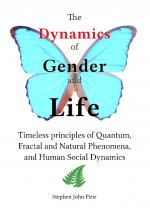We may appreciate, in accordance with KPLLs 1 and 2, that any particular statement, thought, idea or belief that does not explicitly make mention of, or include the at-once reality and participation of both parts and wholes does not represent a root-level truth about life.
This leads us to the third Key Principle of Life, for Life;
Key Principle of Life, For Life, No. 3:
Root-level truths embrace paradoxes1
the at-once reality and participation of parts and wholes
cannot be a root-level all-pervasive truth.
To assert that some statement, idea, fact or belief about some aspect of life is True, while discounting or removing the participation of each part that composes the whole of life is clearly not a complete Truth, but only a biased, limited understanding.
As a corollary of the above principle (KPLL3) we may reasonably conclude that any idea, belief or ‘truth’ that does not explicitly state a paradox, is not a root-level truth.
These three Key Principles can be used to expose beliefs that are only partially true (within limited contexts). They can be used to clarify, expand and correct limited, self-serving beliefs in all areas of life, including science, politics, religion, new-age philosophies, sex and relationships.
Application: Science
Science, due to its reliance on the serial, sequential process of rational thinking and conscious reasoning, cannot devise theories that encompass the at-once nature of life. All scientific theories that can be validated experimentally are operationally restricted by speed-of-light forces and interactions that cannot ‘get around fast enough’ to account for, or explain the instant1 at-once interconnectedness of wholes.
For example, science might identify (count, define) the parts (citizens) that compose a community, but science will not be able to identify, measure or control the all-at-once ‘glue’ -- the 'community spirit' - that makes for loving families, or close-knit communities or patriotic nations. We may recognise that ‘glue’ in the form of love, commitment, loyalty or even guilt, but these (limitless) dimensions to personal experience cannot be entirely reduced to any limited-dimension (physical) system, or to any scientific fact or theorem.
The either-or thinking in science (see KPLL No.2) leads to the reductionist model – a belief that the whole can be reduced to an explanation of the parts, independent of the at-once relationships that create meaningful wholes and gestalts in the form of marriages, families, communities and nations etc.
That is to say, due to the inherent limitations of reasoning and the scientific method, there will remain a fullness (wholeness) to life that will not be comprehended through rational thinking or be fully revealed by scientific inquiry.
Scientific facts, proofs and theorems violate Key Principles of Life, for Life No’s 1,2 and 3. As such they can not be root-level truths about life, no matter how rigorous, factual, consistent or obvious the evidence for said beliefs, proofs or facts.
Notes:
1An instantaneous connectedness (nonlocality) has been ‘conversely-proved’ (mathematically) and experimentally verified in quantum physics research. A conceptual basis for the requirement for an instant and all-pervasive interconnectedness is provided (tba).
1See also KPLL3a: The Pairadox rule, which is a corollary (spin-off) of KPLL3.
 "The Dynamics of Gender and Life" ebook is now available at
"The Dynamics of Gender and Life" ebook is now available at